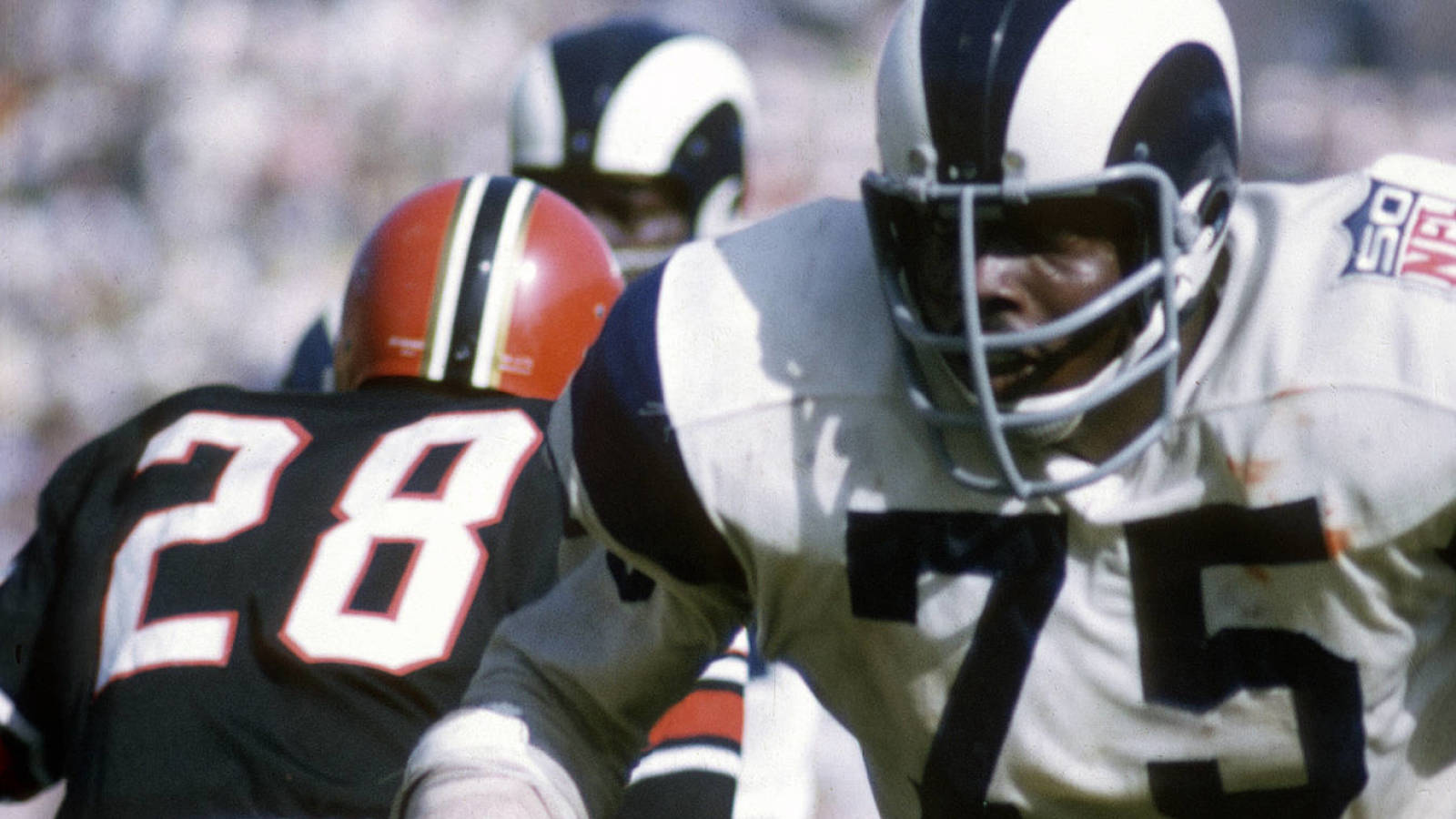Pro-football-reference.com’s sack-compiling efforts for some past eras shed some light on previous generations’ pass rushers who have, for the most part, not getting their due. Here are the players from that era who retired with the most sacks. Some of these players’ careers stretch into the official sack era (1982-present); in those cases, the pre-modern (1960-81) and modern numbers are combined.
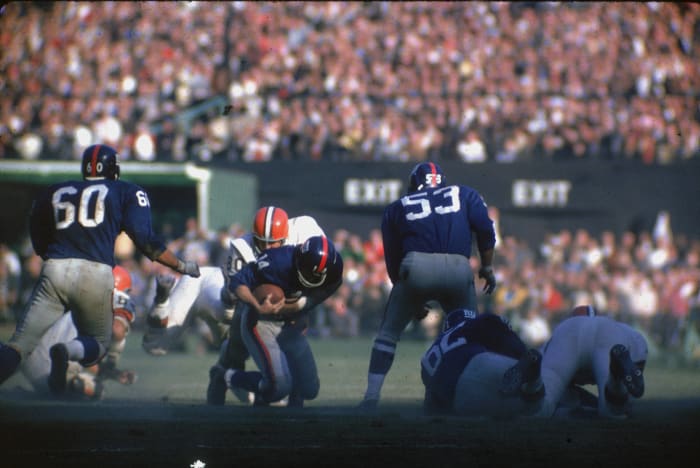
Robert Riger/Getty Images
An integral part of the Browns’ 1964 NFL champion team and the 1965 squad that advanced back to the title game, Glass has now been credited with 87 career sacks. Acquired from the Lions in a 1962 deal that involved quarterbacks Milt Plum and Jim Ninowski switching sides, Glass started every Browns game for the next six seasons. The right defensive end received four Pro Bowl nods in that span, and he ripped off three 15-sack seasons during the 14-game era. Glass played a major role in the Browns shutting out the Colts in the 1964 title game; he sacked Johnny Unitas twice that day.

Nate Fine/Getty Images
One of his era’s bigger defensive ends, the 275-pound Biggs split his career with the Jets and with Washington. Altogether, he is credited with 90.5 sacks. Biggs notched four straight 10-plus-sack seasons with the Jets in the late 1960s, residing as one of the top players on the Joe Namath-centered 1968 squad that stunned the Colts in Super Bowl III. Biggs posted 15 sacks in 1967 and, after being traded to Washington for first- and second-round picks in 1971, became part of trade-happy George Allen’s “Over the Hill Gang.” Biggs started for the Super Bowl VII-bound 1972 Washington team and added 15 sacks in ’73.
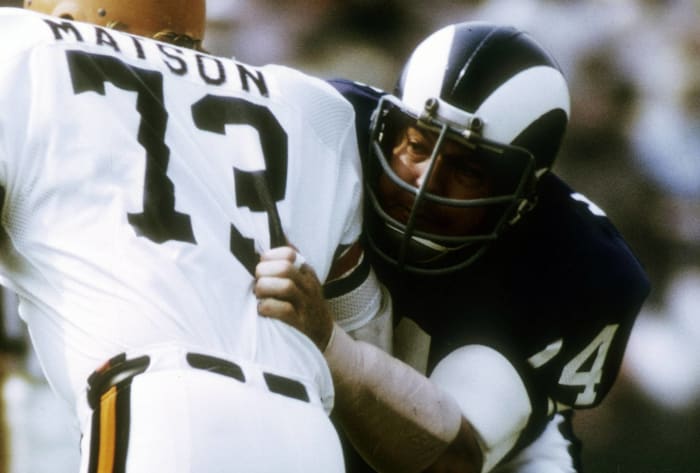
Focus on Sport/Getty Images
Olsen helped enable Deacon Jones’ havoc sprees, with the Hall of Fame defensive tackle never missing a game. In those 208 regular-season contests, Olsen finished his career with 91 sacks. The enduring Los Angeles inside presence anchored the Rams’ “Fearsome Foursome” defensive line and began his career with 14 consecutive Pro Bowls, often taking on double-teams that freed up teammates. Overall, Olsen went 14-for-15 in Pro Bowls. Playing at around 280 pounds, Olsen provided the Rams with incredible consistency and peaked during a late-1960s run in which L.A. went 32-7-1 from 1967-69.
4 of 30
27. Jim Katcavage
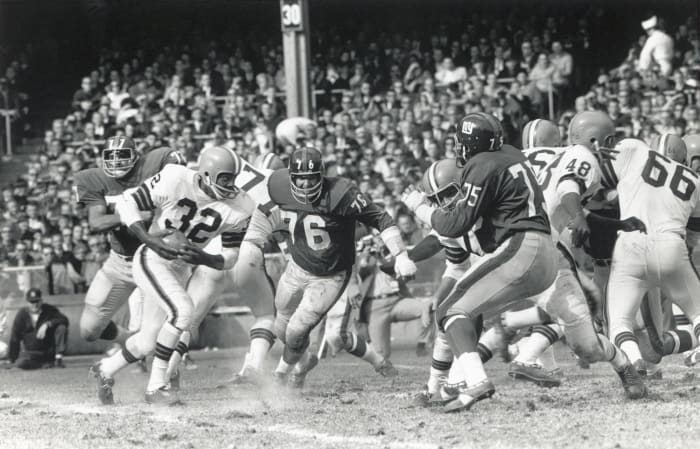
Robert Riger/Getty Images
Katcavage’s clarified sack total lands on this list, despite the productive defensive end’s career beginning before 1960. Katcavage’s first four seasons transpired in the 1950s when he served as Andy Robustelli’s complementary edge defender in Tom Landry’s 4-3 scheme. From 1960-68, Katcavage is credited with 91.5 sacks. He played in six NFL Championship Games — three in the ’50s, three in the ’60s — and took over as the Giants’ top sack artist for the latter stretch. Katcavage led the NFL in sacks in 1962 and ’63, combining for 36.5 in that span.
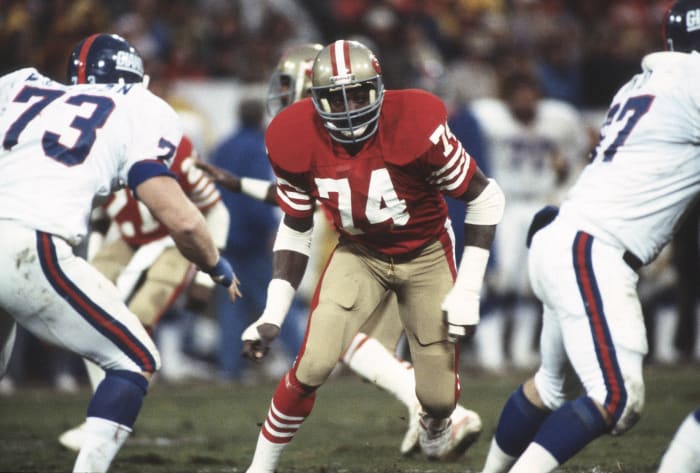
Focus on Sport/Getty Images
Dean split his career between San Diego and San Francisco, racking up 92 sacks. After the Hall of Fame defensive end’s sixth Chargers season, a 1980 campaign that produced his first All-Pro nod, the Bolts traded him to the 49ers rather than meet his contractual demands. This cost the Chargers, whose defense kept an all-time offensive arsenal out of the Super Bowl. Dean earned All-Pro acclaim for the 49ers in 1981, registering 13 sacks to help San Francisco win its first Super Bowl. Dean added a career-high 17.5 sacks in 1983 and was on the 49ers’ 1984 Super Bowl-winning squad.
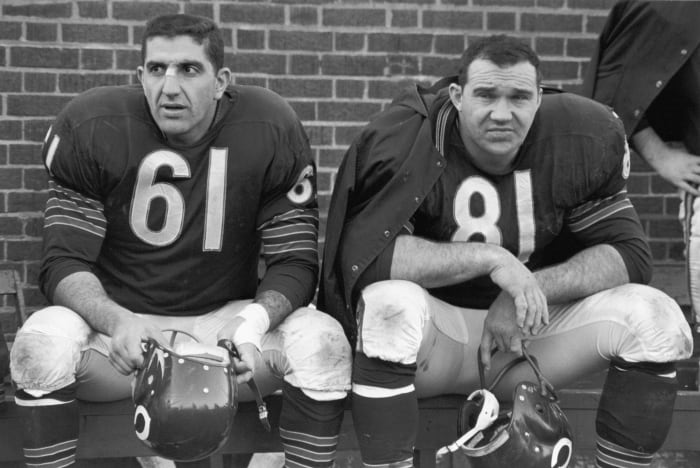
Robert Riger/Getty Images
The 1960 line of demarcation for sack compiling bisects Atkins’ Hall of Fame career. Were the 1950s also charted, the Bears rusher would be closer to the top. In the ’60s, after age 30, Atkins accumulated 94.5 sacks. Gargantuan for the era, the 6-foot-8 Atkins bullied left tackles for over a decade. He was the best rusher on the 1963 Bears’ No. 1-ranked defense, which preserved George Halas’ final championship. Interestingly, the retroactive sack-inspection effort reveals Atkins’ most productive season to have come for the Saints in 1968, when he totaled 12.5 at age 38. Atkins closed his 17-year career with three Saints seasons.

Bettmann/Getty Images
“Mr. Cowboy” now checks in with 95.5 sacks. Sacks were not the primary responsibility for the all-time great defensive tackle, but Lilly’s interior-rushing ability provided a boost to a Cowboys team whose “Doomsday” defense featured no one better. Lilly’s top single-season total came in 1966 when he registered 15 in Dallas’ first playoff year. The Cowboys made seven more postseason appearances during Lilly’s 14-year career, and he contributed one of the most impactful sacks in NFL history during this run. Lilly dropped Bob Griese for a 29-yard loss in Super Bowl VI — a 24-3 Cowboys win.
8 of 30
T-21. George Martin
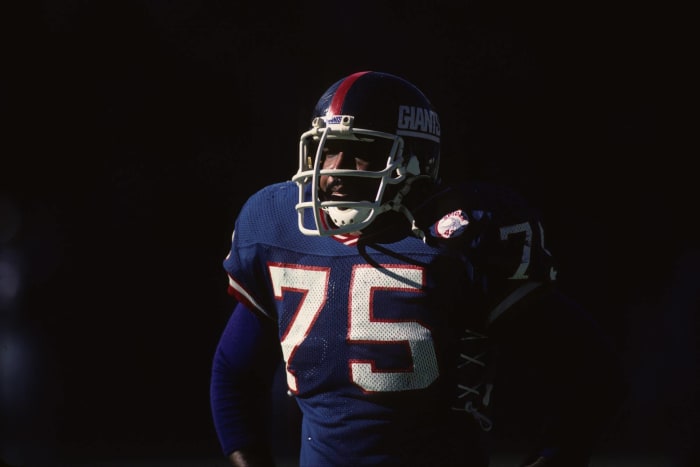
George Gojkovich/Getty Images
Like Harry Carson, Martin toiled on some bad Giants teams in the 1970s. The franchise’s fortunes and Q rating changed after Lawrence Taylor’s 1981 arrival, and Martin hung around long enough to play a big part in Super Bowl XXI. The 14-year veteran finished his career with 96 sacks. His most notable sack did not count in this total. Martin dropping John Elway for a safety in Super Bowl XXI preceded a Giants onslaught. Martin, who also returned all three of his career interceptions for touchdowns, put together four double-digit sack seasons while helping the Giants rebound in the 1980s.
9 of 30
T-21. Carl Hairston

Sylvia Allen/Getty Images
Hairston hung around even longer than Martin, playing 15 NFL seasons from 1976-90. He only went into double digits once, a 15.5-sack year in 1979, but the defensive end was an essential presence on contending Eagles and Browns teams. “Big Daddy” got to 96 sacks, starting for back-to-back Eagles teams that ranked first defensively — including their Super Bowl XV outfit. The Eagles shipped Hairston to the Browns for a ninth-round pick (current Chiefs special teams coordinator Dave Toub) in 1984. Hairston started on each of Marty Schottenheimer’s four playoff-bound Browns teams in the ’80s.
10 of 30
T-21. Ezra Johnson
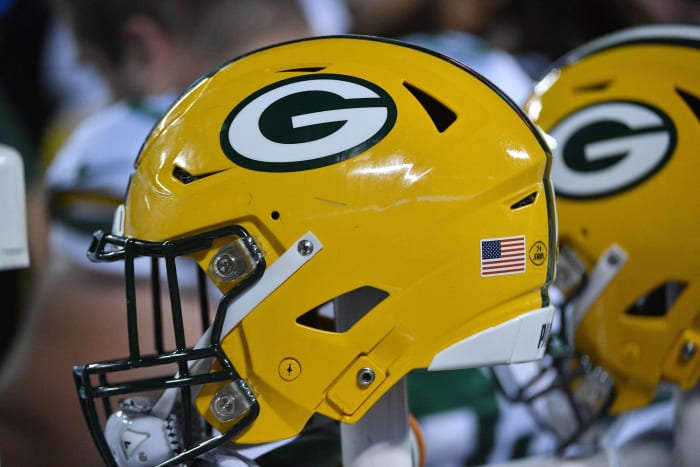
Denny Medley-USA TODAY Sports
Nearly 20% of Johnson’s 96 sacks came in a dominant 1979 season, his second year in the league. But the Packer first-round pick played 15 seasons, making it into the 1990s with the Oilers. Johnson played 11 seasons in Green Bay, during a bad Packers period, and totaled at least nine sacks in four of those campaigns. Before full-fledged free agency, the defensive end managed to secure such status twice. He migrated to Indianapolis in 1988 and Houston in 1990. Despite operating as a backup, Johnson tallied 8.5 sacks at age 34 with the Colts in 1989.

Focus on Sport/Getty Images
Never honored with a Pro Bowl in his 14-year career, Pugh collected two Super Bowl rings and thrived as a pass rusher for a period. Driven by his strong late-1960s stretch pursuing passers, Pugh finished his career with 96.5 sacks. Lilly overshadowed his Dallas defensive tackle mate and certainly made life easier for Pugh, but the latter led the Cowboys with 13.5 sacks during the team’s first Super Bowl-winning season (1971). This concluded a four-year stretch of double-digit sacks. Pugh also dropped Bart Starr for three sacks in Dallas’ “Ice Bowl” loss.
12 of 30
19. George Andrie

Focus on Sport/Getty Images
Lined up alongside Lilly for years, Andrie joined the Hall of Famer and Pugh on a formidable Dallas defensive front. Andrie logged 98.5 sacks in his 11-year career, leading the “Doomsday” defense’s first nucleus in QB drops. Entering the NFL a year after Lilly, the 1962 sixth-round pick reeled off a six-year stretch of double-digit sacks. This peaked in 1966, when he led the NFL with 18.5, and also included a 14.5-sack 1965 season. Andrie remained a starter through Dallas’ 1971 Super Bowl-winning season.
13 of 30
18. Willie Davis
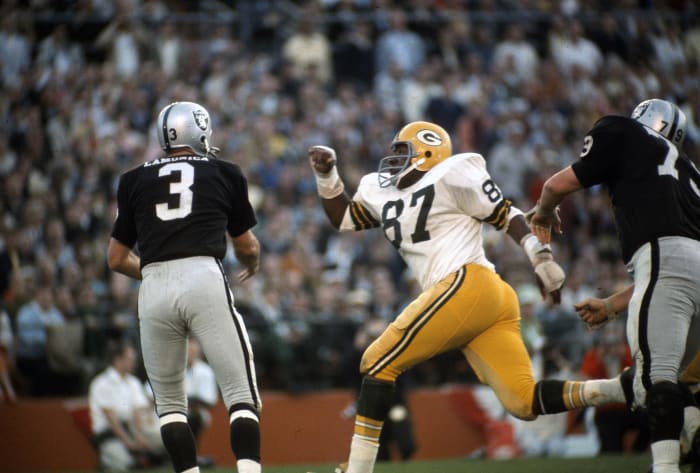
Focus on Sport/Getty Images
Davis began his career two years before the retroactive sack-counting effort’s range, but the entirety of his Packers tenure occurred in the 1960s. The Packers acquired the former 15th-round pick from the Browns in 1960. The Vince Lombardi teams’ top pass rusher, Davis is being credited with 99.5 sacks from 1960-69. Green Bay’s strong-side defensive end amassed more than 10 sacks in five seasons and reached at least 9.5 in each of the team’s five championship seasons in its storied decade. The Hall of Fame rusher added four playoff sacks in 1967, dominating for three against the Raiders in Super Bowl II.
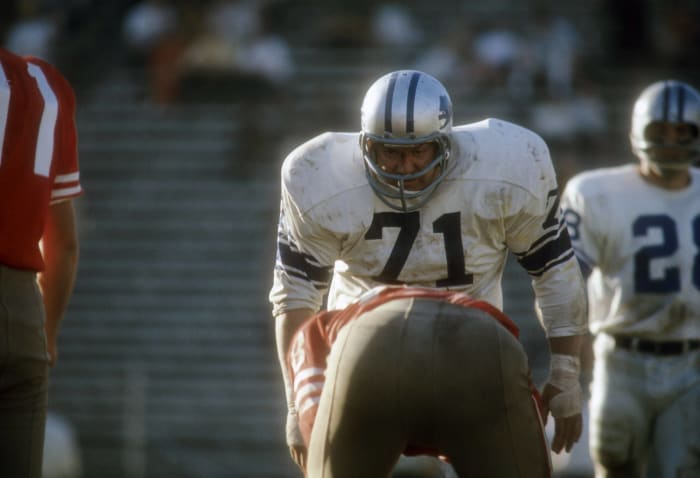
Focus on Sport/Getty Images
Karras’ first two NFL seasons did not qualify for these newly unearthed sack totals, but his 10-season sample produced a round, 100-sack figure. Although Karras is not in the Hall of Fame, with his 1963 gambling suspension hurting him on that front, he was a dominant inside pass rusher in the 1960s. The former top-10 Lions draftee was a three-time All-Pro and notched five double-digit sack seasons. The Packers did well to lower the Lions’ ceiling in the ’60s, but Detroit still fielded a few good defenses on the backs of Karras and Canton-bound cogs. Karras topped out with 15 sacks in 1965.
15 of 30
T-15. Fred Dryer
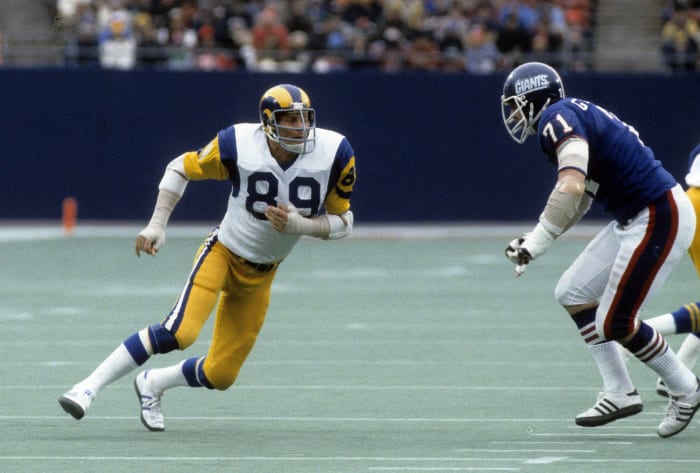
Focus on Sport/Getty Images
Prior to his acting career, Dryer teamed with Jack Youngblood to form a high-end edge-rushing tandem with the Rams. The 13-year veteran checks in with 103 career sacks, doing the bulk of the damage for some talented Rams teams in the 1970s. The Rams won seven straight NFC West titles from 1973-79; Dryer started for each team. Dryer registered two safeties in 1973 and led the NFL with 15 sacks a year later. Both the Giants and Patriots traded Dryer in 1972; he never played in New England. But he broke out with the Giants, recording 12.5 sacks in 1970 — his second season.
16 of 30
T-15. Tony McGee
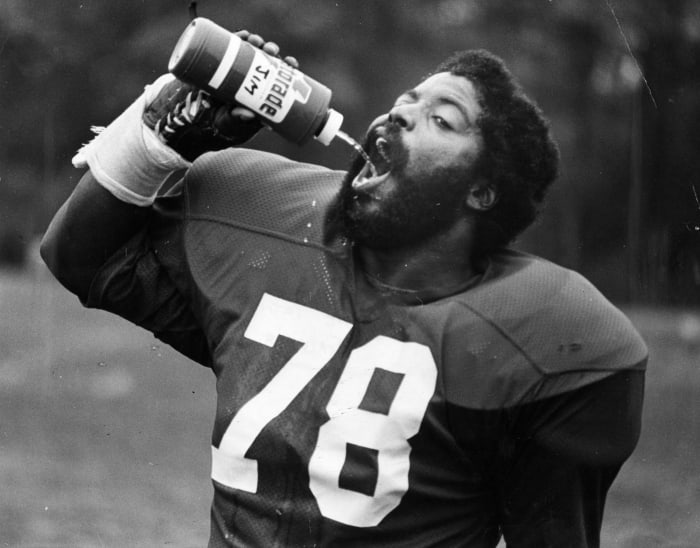
Frank O’Brien/The Boston Globe via Getty Images
McGee bounced to three teams during his 14-year career and played key roles on two contenders. Despite not being a regular starter too often, McGee finished with 103 sacks between his time in Chicago, New England, and Washington. Part of two September trades, neither of which involving anything above a third-round pick, McGee put together a stretch featuring four straight 11-plus-sack seasons for some quality Patriots teams in the 1970s. The Pats dealt the defensive end to Washington in 1982. He promptly helped Washington win Super Bowl XVII and, via a 10-sack season at 34, advance to the next year’s ultimate game as well.
17 of 30
14. Elvin Bethea
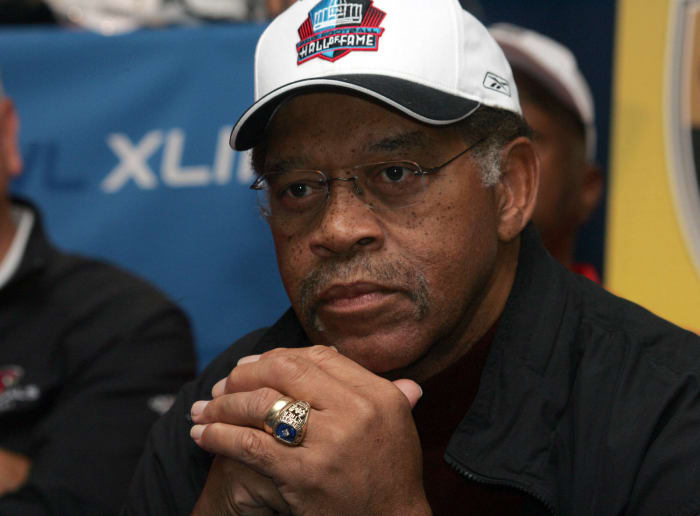
Cliff Welch/Icon Sportswire
Part of a three-Hall of Famer Oilers front seven, along with defensive tackle Curley Culp and outside linebacker Robert Brazile, Bethea played in Houston the longest and tallied the most sacks. The 16-year Oiler got to 105, with the bulk of them coming in his 20s and early 30s. While Bethea hung on through 1983, he was a perennial Pro Bowler in the 1970s and became one of the first great 3-4 defensive ends. Before the 1978 switch to 16 games, Bethea produced three 14-plus-sack seasons — the first of which coming in his second season as a pro in 1969 — and helped the Oilers rebound on his way to Canton.
18 of 30
T-12. Jack Gregory
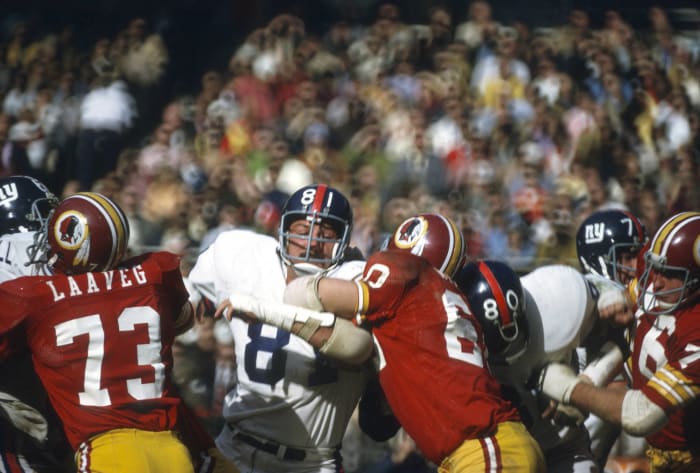
Focus on Sport/Getty Images
A standout for the Browns and Giants, Gregory is now credited as a member of the 100-sack club. The update gives the talented defensive end 106 for his 13-year career. The Browns nabbed Gregory in the ninth round of the first common draft (1967), and he led the pass rush for playoff-bound Cleveland teams as a young player. Gregory totaled 26.5 sacks from 1969-70, adding three in the 1969 playoffs, but the Browns dealt him to New York in 1972. Though the Giants were in for some lean years, Gregory transitioned quickly — via an 18.5-sack 1972 — and delivered a 14-sack season at age 31 three years later.
19 of 30
T-12. Ed “Too Tall” Jones
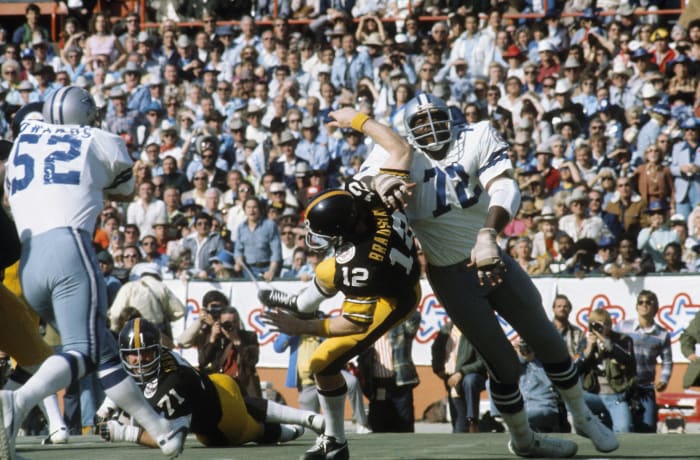
Focus On Sport/Getty Images
The tallest of this list’s many Cowboys, Jones lasted long enough to play for Jimmy Johnson — the 1-15 Dallas iteration, but still. The 6-foot-9 edge player played opposite Harvey Martin for much of his career, on a D-line that also included perennial All-Pro Randy White. Unlike White, Jones started for three Cowboys Super Bowl teams. Via a 1973 trade with the Oilers, the Cowboys drafted Jones first overall in 1974. He totaled 106 sacks in a 14-year career, which was interrupted by a one-year sabbatical when Jones tried boxing. While Jones only surpassed 10 sacks twice, both seasons came in his mid-30s.
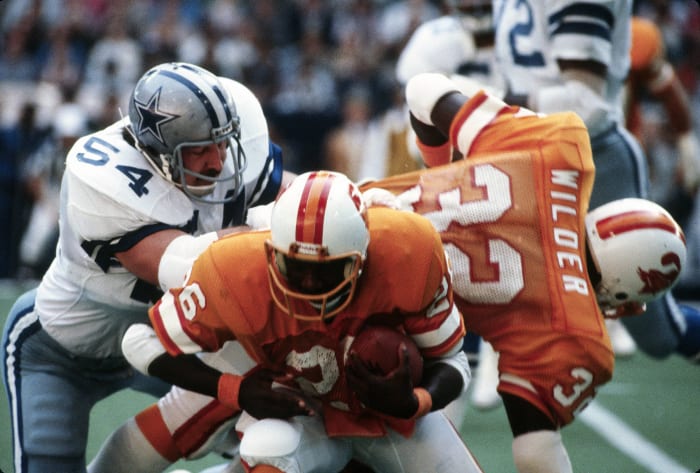
Focus on Sport/Getty Images
White took over for Bob Lilly as the face of the Cowboys’ defense, joining the team during the offseason when the fellow Hall of Fame defensive tackle retired. The No. 2 overall pick in the 1975 draft, White played 14 seasons and finished with 111 career sacks. “The Manster” made nine straight Pro Bowls from 1977-85, playing in three Super Bowls and six NFC championship games. White did not break into Dallas’ starting lineup until 1977. That promotion went well, with the converted linebacker totaling 12.5 sacks and earning co-Super Bowl XII MVP honors. White finished with five double-digit sack seasons, the last coming in 1985.

Focus on Sport/Getty Images
Alzado collected a Super Bowl ring with the Raiders, but his best years came as a Bronco. The brooding defensive end is now credited with 112 sacks in his 15-year career. Alzado became one of the NFL’s best D-linemen in the 1970s, peaking as a 3-4 end for the Broncos’ “Orange Crush” defense in the latter part of the decade. Alzado made two Pro Bowls as a Bronco and added a third in Cleveland, following a trade. Amassing only two 10-sack seasons, Alzado was more consistent than flashy. While he became a cautionary tale, after admitting excessive steroid use, he produced for several playoff teams.
22 of 30
9. Harvey Martin
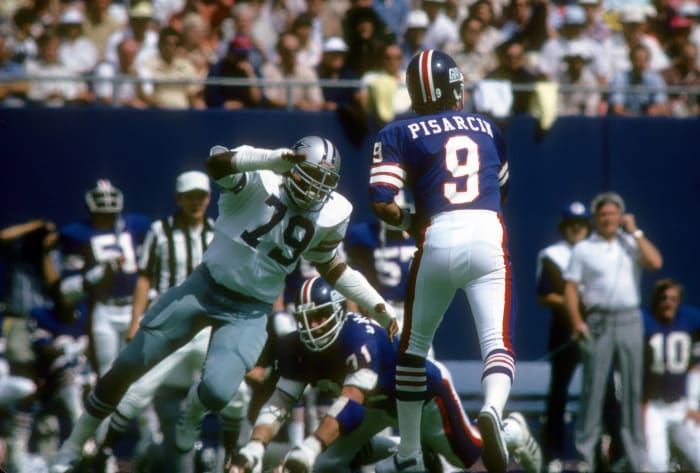
Focus on Sport/Getty Images
Ready to contribute from the jump, Martin recorded nine sacks as a rookie and excelled throughout his 11-year career. The career-long Cowboy is credited with 114 sacks. While 20 of them came in the defensive end’s transcendent 1977 season, in which he was named Defensive Player of the Year and Super Bowl co-MVP, Martin made four Pro Bowls to close out the ’70s. He helped Dallas to three Super Bowls and remained productive into his early 30s when the Cowboys qualified for three straight NFC championship games to open the ’80s. Martin added 17 sacks in 22 playoff games.
23 of 30
8. Cedrick Hardman

James Flores/Getty Images
Hardman quickly showed his talent, leading the NFL with 18 sacks in his second season (1970). He became the top pass rusher on the 49ers’ “Gold Rush” defensive line, finishing the 1970s with an NFL-most 108 sacks. For his career, Hardman is credited with 122.5. The sack specialist did not disappoint throughout his San Francisco stay, finishing only one 49ers season with fewer than eight sacks. His consistency ended up being rewarded when the 49ers traded him to the Raiders for fifth- and sixth-round picks in 1980. The ’80 Raiders, bolstered by Hardman’s 9.5 sacks, became the first wild-card team to win a Super Bowl.
24 of 30
7. Claude Humphrey

Richard Stagg/Getty Images
One of the most efficient sackers in NFL history, Humphrey retired with 130 in 171 games with the Falcons and Eagles. The polished defensive end was ready immediately, joining the Falcons as a No. 3 overall pick and beginning his career with four straight double-digit sack seasons. Humphrey never led the league in the category but made six Pro Bowls with the Falcons — the last of which coming on their 1977 “Grits Blitz” defense that set the 14-game era record by yielding just 9.2 points per game. After a dispute in 1978, Humphrey resurfaced in Philly. At 36, he posted a career-high 15.5 sacks to lift the Eagles to Super Bowl XV.
25 of 30
T-5. Jim Marshall

Focus on Sport/Getty Images
We come to this list’s “Purple People Eaters” sector. Marshall can be viewed as a compiler, but the fact that he could still compile sacks into his 40s represents a stunning durability feat. The 20-year veteran defensive end finished his career with 130.5 sacks. He both predated his higher-regarded D-line mates and outlasted them in Minnesota. One of a few D-linemen the Browns dealt away in the early 1960s, Marshall played his final 19 seasons with the Vikes. His best single-season sack number (14) came when Minnesota held teams to 9.5 points per game en route to Super Bowl IV. Marshall started for three more Super Bowl teams.

Nate Fine/Getty Images
The 1971 Rams had four players on this list on one D-line. Bacon teamed with Deacon Jones, in his final Los Angeles season, along with Merlin Olsen and Jack Youngblood. Bacon later worked alongside Youngblood, Olsen, and Fred Dryer. But Bacon’s best work came elsewhere. Producing for four teams, Bacon totaled 130.5 sacks in his 14-year career. The Rams, Chargers, and Bengals traded the sack artist — in deals involving John Hadl, Charlie Joiner, and Lemar Parrish — he notched a double-digit sack season for each and added his last — in Washington — at 38 in 1980. Bacon’s best work came in Cincinnati when he notched 21.5 sacks in 14 games.

Nate Fine/Getty Images
Playing opposite Marshall on the edge for Minnesota’s famed defensive line, Eller approached the former’s longevity vicinity by playing 16 seasons (15 with the Vikings). By the end, Eller amassed 133.5 sacks. Eller offered higher peaks than Marshall, twice getting to 15 sacks — the second instance coming in 1977, at age 35 — and landed on five All-Pro first teams. The Hall of Famer was essential to the Vikes edging the Cowboys and Rams in their 1970s NFC arms race three times. Minnesota’s defense kept the team afloat in between Fran Tarkenton stays. Anchored by Eller’s league-leading sack total, its 1969 unit was one of the era’s best.

Focus on Sport/Getty Images
Page, however, provided the most daunting blocking assignment for O-lines that tangled with this defensive quartet. One of the NFL’s best players for many years in the 1970s, Page ended his 15-year career with 148.5 sacks. Unofficially, this is the most for a defensive tackle in NFL history. The undersized D-tackle earned six first-team All-Pro honors and became the first defensive player to win the AP MVP award, doing so in 1971, a season in which he is credited with just nine sacks (two of them being safeties). Two seasons after their final Super Bowl, the Vikings waived Page. In 3 1/2 Bears seasons, he combined for 40 sacks.
29 of 30
2. Jack Youngblood
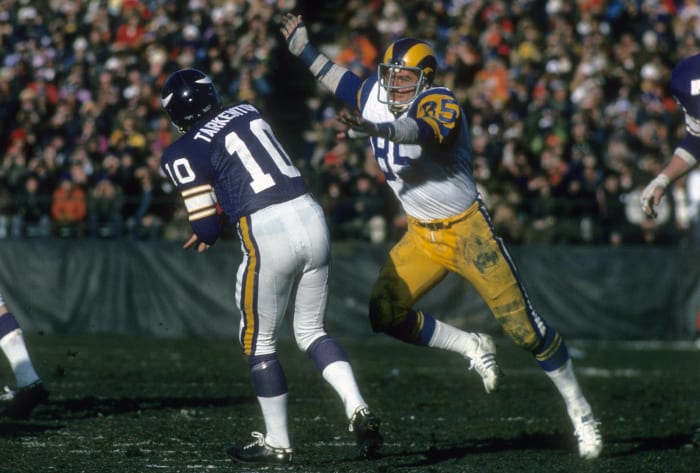
Focus on Sport/Getty Image
The Rams executed an elite baton pass, with Youngblood taking over after Deacon Jones’ departure. Both are in the top 10 all-time in sacks; Youngblood’s 151.5 are unofficially sixth. Los Angeles’ relentless left defensive end is partially known for playing on a broken leg in the 1979 playoffs, but he made seven straight Pro Bowls and landed on the All-Decade team. Youngblood remained productive until his retirement after the 1984 season, recording at least 9.5 sacks in his four non-strike-shortened seasons past age 30. He remained a starter through 1984, helping two new-look Rams squads to the playoffs.
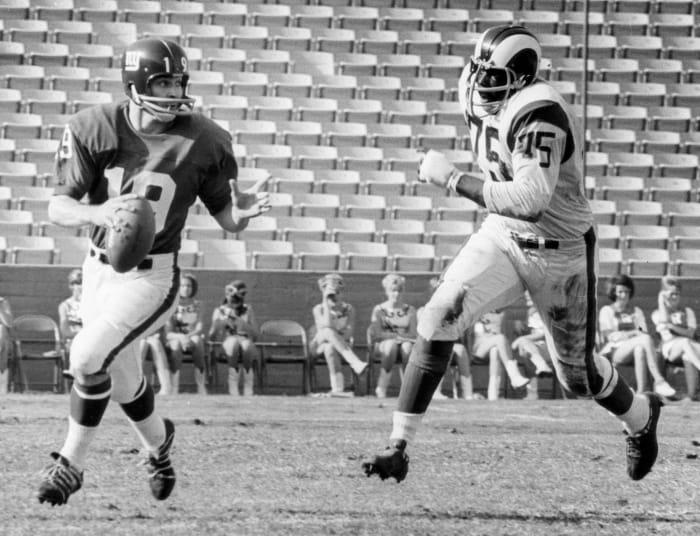
Vic Stein/Getty Images
This retroactive sack-statting operation benefits the Rams, who now have three players in the all-time top six. The godfather of the sack has bumped Kevin Greene down a slot. Jones’ unofficial total (173.5) drops in at No. 3 all-time — behind only Bruce Smith and Reggie White. While D-linemen had more tools at their disposal when Jones played — including Jones’ since-outlawed head slap — and O-linemen had less, his 1960s rampage left no doubt about his abilities. The former 14th-round pick led the NFL in sacks five times in six seasons in a torrid stretch to close out the ’60s. Unofficially, Jones’ three 20-sack seasons top J.J. Watt’s two for most ever.
For all the latest Sports News Click Here

